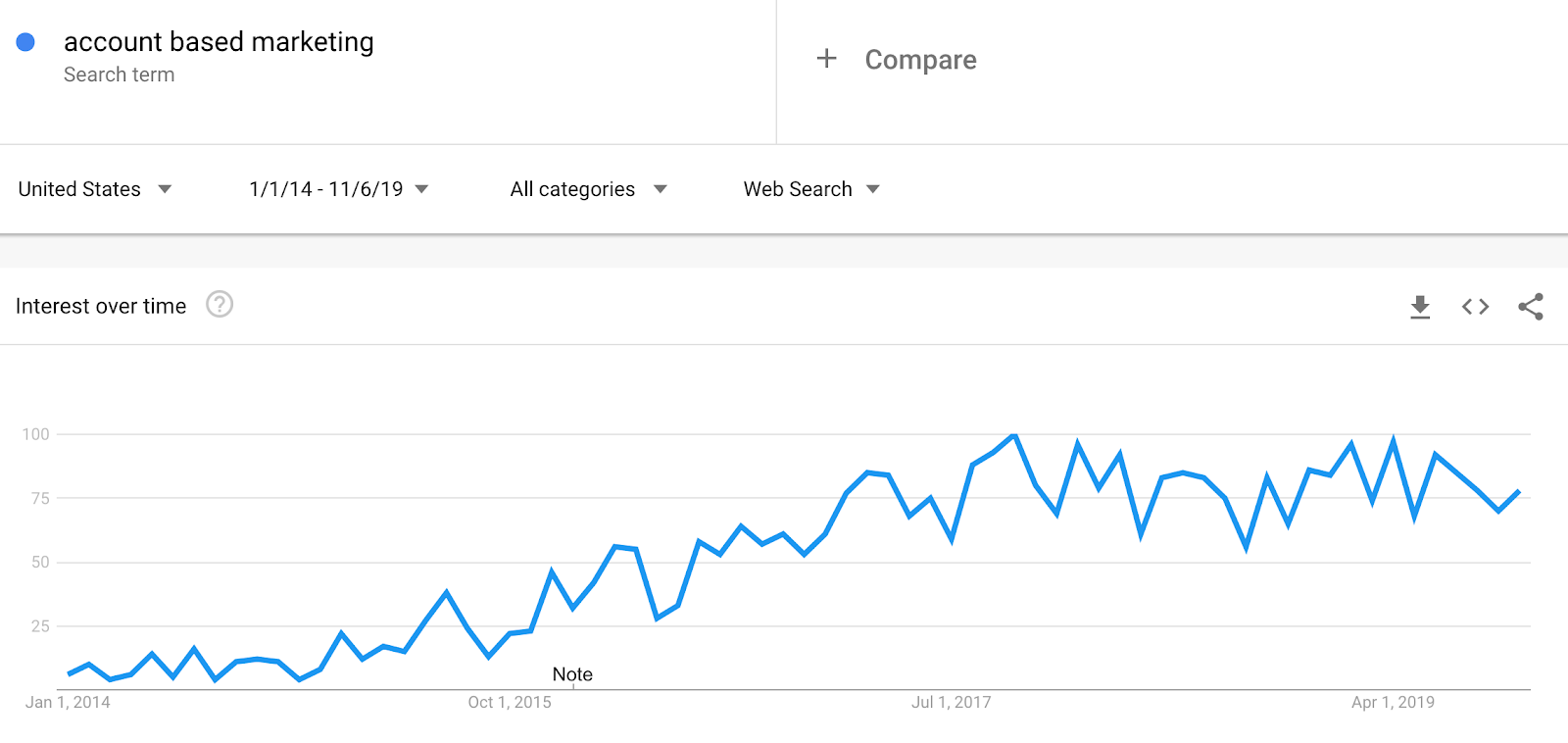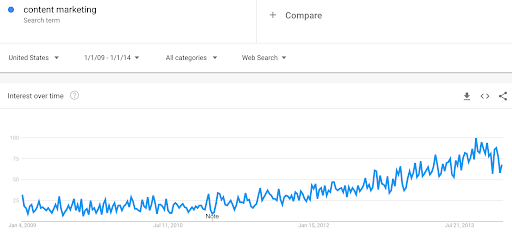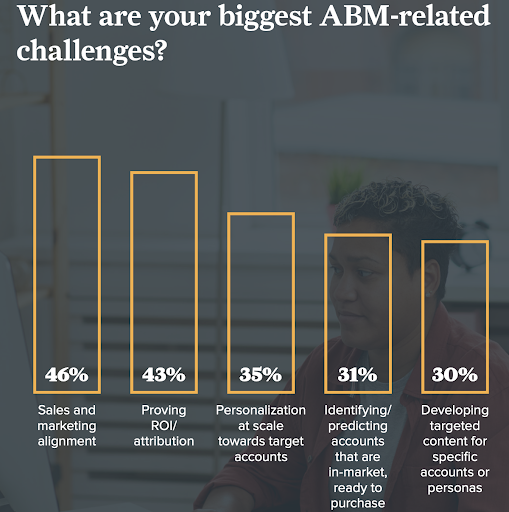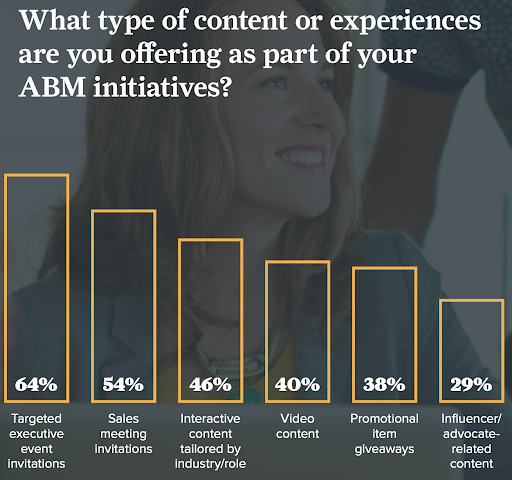
I’ve attended two B2B conferences in the past few months – B2B Sales and Marketing Exchange in Boston, and MarketingProfs B2B Forum in Washington DC – and at both, account-based marketing was unmistakably top-of-mind. A majority of sessions and conversations evoked the term in some fashion, matching the trend I’ve noticed online and in client interactions.
A look at the Google Trends trajectory for “account based marketing” over the past five years reminds me a bit of the trajectory for “content marketing” in the five years prior.


It’s only natural that B2B organizations everywhere are either adopting or taking an interest in ABM, because the strategy is founded on so many key pillars of effective marketing today: personalization, organizational alignment, and the focused pursuit of high-value customers.
Understanding the state of ABM and where it’s heading is critical for any B2B marketing practitioner today. Based on what I’ve been picking up at these events, along with data shared in the newly released 2019 ABM Benchmark Survey Report from Demand Gen Report, here are five trends to focus on as we move into 2020.
5 Key ABM Trends to Plan Around in 2020
The fourth annual ABM benchmark study from Demand Gen Report, which surveyed more than 100 B2B business executives from various industries, ranging across several roles, serves to confirm and reinforce a number of trends we’re seeing in the world of account-based marketing.
1. ABM is B2B Marketing
Only 6% of respondents in the survey said they are not doing ABM yet in any form. Meanwhile, 50% said they’ve had their ABM initiatives in place for more than a year, while another 25% gotten started within the past six to 12 months.
When we covered Demand Gen Report’s 2016 survey on ABM benchmarks, only 47% of respondents said they had an ABM strategy, so clearly the practice has grown substantially in a span of three years.
For me, this growth not only signals that B2B brands are increasingly conscious of creating content and experiences for specific buying audiences, but that those efforts are aimed beyond a singular buyer. After all, one of the major premises of ABM is acknowledging that different people with different viewpoints make up a buying committee, something that every B2B marketer needs to pay attention to on the go-forward.
2. Sales and Marketing Alignment is the Biggest ABM Challenge
Most companies report being in the earlier stages of ABM maturity, and it’s evident that sales and marketing alignment is a common barrier to progress, with a leading 46% of survey respondents citing it as their biggest ABM-related challenge.

(Source: 2019 ABM Benchmark Survey Report)
This struggle isn’t unique to account-based marketing, of course, but ABM is uniquely positioned to help solve it. A strategic and sophisticated ABM program is built on orchestrated account selection, outreach, and nurturing processes. These strategies also tend to measure success based on overall results rather than getting bogged down in credit attribution, helping reduce friction and internal contention.
Better alignment between sales and marketing can contribute to a successful ABM program. But the opposite is also true. Creating unity around such an initiative might begin with changing the way we talk about it. In his session at B2B Marketing Exchange (B2BMX) back in February, Oracle’s Kelvin Gee explained that his team prefers to remove the word “marketing” from the phrase because it can feel isolating and disconnected. “We believe words matter,” he said. “We just call it ‘account-based’ because we’re all in it together.”
Rather than account-based MARKETING, we just call it account-based because we’re all in it together. @kgee #AccountBased #ABM Share on XCertainly, successfully achieving sales and marketing alignment has been a top challenge for brands for ages. But B2B marketers can be the change agents here, as Shahid Javed of Hughes Network Systems shared during his B2BMX session. “Marketing is a service provider to sales—sales is our customer. We need to be able to empower them and enable them to solve problems. We need to make them the hero in the buyer’s eyes.”
Sales is our customer. We need to be able to empower them and enable them to solve problems. @shahidj #SalesAndMarketingAlignment Share on XFor a framework to actualize sales and marketing alignment, you might start with this three-phase approach from Shahid:
- Listening and Information Gathering (Engaging stakeholders and simply listening to what they have to say.)
- Finding the Sweet Spot (Analyzing your data to create a mutually beneficial plan that can bring everyone together—and get C-suite buy-in.)
- Empowering Execution (Making it easy for the sales team to get the marketing and sales collateral they need to be the hero for their customers.)
3. Sales Teams Are Driving Account Selection
When asked how they build and formulate their targeted account lists for ABM, a whopping 80% of respondents said this directive is led by the sales team. Here were the other responses in the report:
- Firmographic: 68% currently using, 22% plan to use
- Technographic: 35% currently using, 40% plan to use
- Behavioral/Intent Signals: 55% currently using, 13% plan to use
- Predictive: 26% currently using, 39% plan to use
It obviously makes a ton of sense for sales to be heavily involved with account selection – they know first-hand which types of accounts are easiest to work with and most likely to convert – but there is a clear opportunity for marketing to play a bigger role here, perhaps by taking charge with some of the other methods listed. Technographics (the analysis of potential accounts based on their current technology stacks) appears to be viewed as most promising.
As Ty Heath framed account selection during her talk on combining ABM and social selling at MPB2B: “It boils down to, what accounts do you think will be profitable long-term, will be pleasurable to work with, and do you think you can make a real difference for?” Several voices ought to be involved in reaching these conclusions.
It boils down to, what accounts do you think will be profitable long-term, will be pleasurable to work with, and do you think you can make a real difference for. @tyrona #ABM #SocialSelling Share on X4. B2B Influencers Aren’t Yet Being Widely Integrated
Speaking of clear opportunities, I was stunned by the graph below. Among six types of content and experiences listed for ABM usage, influencer advocate-related content was last in prevalence at only 29%.

(Source: 2019 ABM Benchmark Survey Report)
As I wrote earlier this year, B2B influencers and ABM are a powerful combination. The focused nature of account-based strategies lends itself well to collaborating with subject matter experts who are visible to, and trusted by, the prospects you most want to engage. When you know specifically who you’re trying to reach, you can confidently identify niche influencers that your audience is likely to recognize and listen to. Research shows that people are more likely to trust technical experts and peers in their field than brand-driven messaging.
Seeing this synergy and opportunity, I’m excited for our team at TopRank Marketing to keep expanding our world-class influencer capabilities in the ABM space specifically.
5. Quantity Is the Primary Measurement Focus for ABM
How are B2B marketing executives measuring the success of their ABM programs? Here’s how the responses shook out:
- Net-new accounts engaged (60%)
- Number of qualified accounts (52%)
- Contribution to pipeline revenue (50%)
- Win rate (50%)
- Pipeline velocity (46%)
- Account engagement score (41%)
It comes as no surprise that bottom-line numbers are being prioritized over relative rate metrics. Business leaders want to see results, and considering that 69% of respondents in the survey report that their account-based efforts are meeting or exceeding expectations, it seems those results are there.
Find Your Perfect Fit with ABM
Buzzwords aside, account-based marketing is a very simple and natural evolution for B2B marketing. Whether or not you want to attach the label, virtually every business that markets to other businesses should be adhering to many of ABM’s core principles.
Looking to learn more about ABM and its fundamentals? Check out this primer from our own Josh Nite: What You Need to Know to Get Started with Account-Based Marketing.



